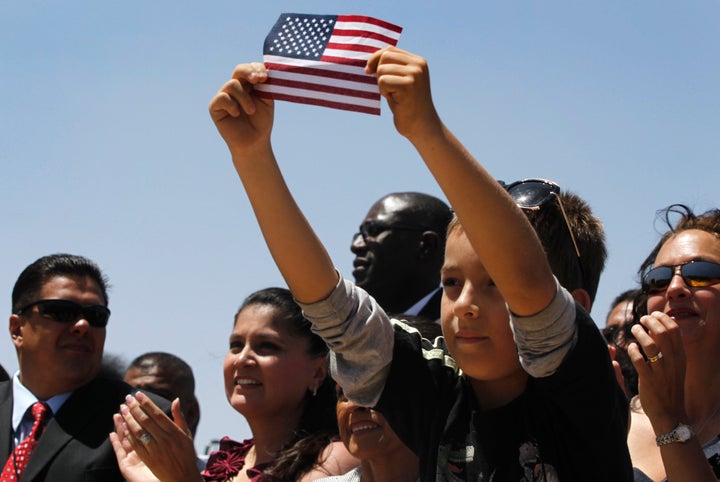
Everybody is talking about the role played by Latinos and about Ohio in last Tuesday's election. I offer a first person account of both. I've written here my reflections on my experience as a Cincinnatian, as a Latino and as a person involved with the president's campaign in Ohio from its inception -- a story that has taken more than a year and a half to complete.
I had this to say back in July: "Republicans are going to get clobbered by Latino voters, who I suspect will come out in record numbers to support the President." Last Tuesday, my informed prediction came true as a full ten percent of those who turned out were, in fact, Latino. In the Buckeye State, 82 percent of Latino voters backed the president, which contributed +1 percent to the President's vote total, according to Latino Decisions' calculations. Without that +1 in the president's column, Mitt Romney would have had a much greater probability of winning Ohio than what ended up being the case.
There's no mystery about how this happened. In Southwest Ohio and across the state, we began to lay the foundational infrastructure for this campaign in spring of 2011. This was the most thoroughly thought through and best-implemented presidential campaign in U.S. history. Ohio was ground zero for any winning national strategy, and our strategy was based entirely on teamwork, which held fast through tense times.
The day after the election, Cindy Rodriguez, CNN's editor for Latino audiences, asked me my opinion on "what drove Latinos to the polls in record numbers?" My best assessment has always been twofold: an anti-Latino GOP strategy that was fully embraced by Mitt Romney and, secondly, a brilliantly conceived, professionally implemented and inclusive ground game by the president's campaign.
On the one hand, Romney ran with the anti-immigrant tide emanating from Arizona and from within his own party's leadership structure. The hateful discourse that ensued negatively resonated with Latinos everywhere in this nation, including in Ohio. Again, the numbers coming out of Latino Decisions -- probably the most reliable Latino-centric numbers in the nation -- indicate that about 31 percent of Latinos would consider voting Republican if the party weren't so out of touch with Latino constituents on immigration reform. As one Latino across the aisle told Jason Margolis for his Thursday report over at The World, Romney's messaging was "condescending. They don't give the Latino community any credit for thinking."
'Self deportation?' Great idea! And gee shucks, while we're at it, why not "veto the DREAM Act". This was the full extent of Mitt Romney's "Latino outreach" strategy.
As far as this Latino and Ohioan can tell, the GOP and their defeated standard bearer are neck deep in an anti-Latino political agenda that has taken decades to develop. That strategy is so caught up in the cultural fabric of the GOP that it will take the next decade before it even begins to unravel (best case scenario).
And then there was the president's proactive campaign in the Buckeye State. With more than 11 million people, Ohio is more diverse than most folks understand. That diversity is no less salient among our Latino community. In each part of the state -- SW, Central, NE, NW, NCentral -- there is a different culture, there are different interests and different needs. And yet our community leaders were able to set those differences aside, to pool our unique resources, and to work with each other both to inform our communities on the critical issues and, as members of the Ohio Latino Leadership Council to reelect the President, to advise the campaign as it navigated an intensely complex socio-political terrain.
Of course, there are no heroes in politics. One of my favorite social theorists, Max Weber, once wrote, "politics is the strong and slow boring of hard boards." Still, if I can highlight one person who held the rugged ship of Ohio's Latino Leaders together it would be Isabel Framer. Isabel is a long-time trailblazer, fighting for equal access and civil liberties for Ohio's Latino community. She is a dear friend and ought to be openly considered an inspiration among the best of us.
And, as Baldemar Velasquez, president and founder of the Farm Labor Organizing Committee (FLOC), reminded some of us in an email note, this was a door-to-door campaign with many parts and even more people. He told how Sesario Duran, FLOC Secretary Treasurer, "led more than 20 FLOC volunteers and targeted and knocked on over 2500 Latino household doors in the greater Toledo area in the last two and a half weeks of the election." That perfectly exemplifies what I mean when I say "professional and inclusive."
In sharp contrast with Romney's, the president's campaign brought in some of the most respected leaders from across the vast spectrum of Ohio's Latino community, folks with a staggering array of expertise areas and a diverse set of beliefs and methods. They asked for our help; we lent them our hand.
Our work, together with the president's campaign, brought Ohio's Latino electorate on board. From Columbus to Cleveland, across the northern band to Toledo, and down 75 South to Dayton and Cincinnati, we helped to create the Midwest Firewall.
I'm proud of the results: we met the Republican Party and their standard bearer head-on, we stood our ground on the right side of history, and we won. Eighty-two percent of Ohio's Latino voters helped to reelect President Barack Obama, the 44th President of the United States of America.